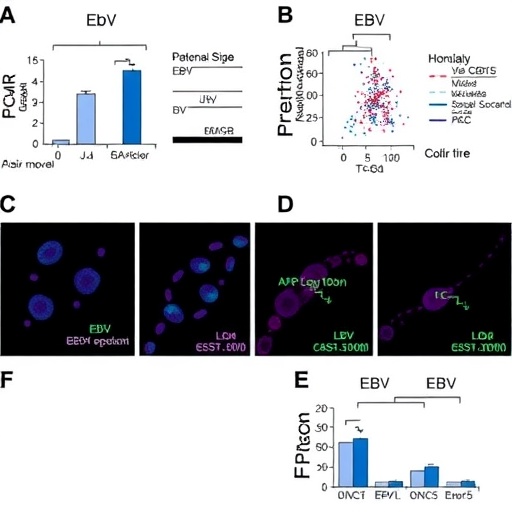Emerging from the shadows of virology, recent findings reported by a team of researchers delve into the complexities of the Epstein-Barr virus (EBV) and its implications in the proliferation of B-cells within the context of rectal cancer. This study carves a niche within oncological research, highlighting how latent EBV reactivation influences cellular dynamics during the expansion of tumor-infiltrating lymphocytes (TILs) derived from EBV-negative rectal cancer tissues. The implications of such findings extend beyond mere academic curiosity, as they may reshape therapeutic interventions and patient outcomes in the oncological landscape.
At the heart of this investigation lies a paradox: how a virus that typically remains quiescent can awaken the immune system’s B-cells, particularly in tissues associated with malignancies. The researchers meticulously explored these dynamics by isolating tumor tissues from patients diagnosed with rectal cancer. Rather than focusing solely on the malignant aspects of the tumor, their inquiry sought to unearth the viral influences that may distort B-cell behavior. This unconventional approach indicates a burgeoning field of research that intertwines virology with cancer biology.
One of the striking revelations from this study is the role of latent EBV reactivation as a possible driver of aberrant B-cell proliferation. While EBV is commonly associated with lymphoproliferative disorders in immunocompromised individuals, this study posits that even in seemingly EBV-negative tumors, the latent virus can resurface and manipulate the immune landscape. Reactivation of EBV in this context may lead to an environment conducive to uncontrolled B-cell growth, fostering a milieu where malignant processes can thrive unhindered.
The methodology of this research offers a detailed and robust framework for understanding the interplay between EBV and B-cell dynamics. Employing ex vivo techniques, the researchers expanded TILs from these tumor samples, allowing for a closer examination of the immune cells in a controlled setting. This experimental design permitted the team to discern how EBV could potentially hijack cellular machinery to promote B-cell proliferation. Each isolated lymphocyte would serve as a portal into the viral influence, reflecting an intricate dance between pathogen and host.
Furthermore, the study introduces a nuanced perspective on tumor-infiltrating lymphocytes, which are often harnessed in cancer immunotherapy. By identifying the factors that lead to their aberrant proliferation, the team raises critical questions about the efficacy and safety of TIL-based therapies. If the reactivation of latent EBV is indeed a contributing factor to the uncontrolled proliferation of B-cells, this could have significant ramifications for treatment protocols that rely on harnessing these very immune cells for anti-tumor responses.
The findings also reinforce the paradigm that tumors are not immune fortresses, but rather dynamic ecosystems in which viral elements play a crucial part. This opens the door to further investigations into other oncogenic viruses that might similarly influence immune responses within tumors. It raises the critical notion that a comprehensive understanding of a tumor’s viral landscape could lead to more effective treatments, tailored to not just the cancer cells but also the viral entities intertwined within these neoplastic environments.
Importantly, this study emphasizes the potential for detecting latent EBV prior to therapeutic intervention as a means to predict patient responses to immunotherapy. Such insights may guide the stratification of patients, ensuring that those harboring latent viral infections can be appropriately managed during treatment. This could significantly enhance our understanding of the individual responses to therapies and may minimize the risk of exacerbated immune reactions or treatment failures.
Additionally, the implications of these findings extend to post-treatment monitoring. If latent EBV reactivation continues to influence B-cell dynamics even after therapeutic interventions, there could be a necessity for ongoing vigilance in monitoring patient outcomes. The persistence of the virus could transform our approach to follow-up care and survivorship, urging oncologists to remain cognizant of the role that viral reactivation may play in recurrence or disease progression.
As research unfolds, it will be pivotal for the scientific community to engage with these findings, refining our understanding and management of EBV-related complications in cancer. This work embodies the collaborative spirit of scientific inquiry, encouraging further exploration into the viral mechanisms at play within tumors. Harnessing the knowledge gleaned from this research could pave the way for pioneering strategies that redefine cancer treatment, ultimately striving toward personalized medicine that considers both host and viral factors.
In conclusion, the study encapsulates a critical intersection between virology and oncology, offering a compelling narrative on EBV’s concealed role in B-cell proliferation within rectal cancer. The implications are profound, with the potential to unlock new dimensions of therapeutic strategies that incorporate viral influences in the management of cancer. Moving forward, it will be essential for the scientific community to embrace these insights, propelling further research that dances between the realms of pathogen interaction and cancer biology.
This exploration not only contributes to the existing body of knowledge but also poses new questions that will drive the next wave of research in cancer immunotherapy and viral oncology. Each revelation from these studies serves as a stepping stone toward a deeper understanding of the underlying biological processes, fostering a future where cancer care is informed by the intricate relationships within the tumor microenvironment.
Subject of Research: The role of latent EBV reactivation in aberrant B-cell proliferation during tumor-infiltrating lymphocyte expansion from rectal cancer tissue.
Article Title: Latent EBV reactivation drives aberrant B-cell proliferation during ex vivo tumor-infiltrating lymphocyte expansion from EBV-negative rectal cancer tumor tissue.
Article References:
Petrova, T.V., Kuznetzova, D.V., Kanygina, A.V. et al. Latent EBV reactivation drives aberrant B-cell proliferation during ex vivo tumor-infiltrating lymphocyte expansion from EBV-negative rectal cancer tumor tissue. Sci Rep (2025). https://doi.org/10.1038/s41598-025-29456-7
Image Credits: AI Generated
DOI:
Keywords: Epstein-Barr virus, B-cell proliferation, rectal cancer, tumor-infiltrating lymphocytes, viral reactivation, cancer immunotherapy.




